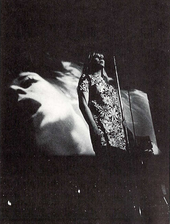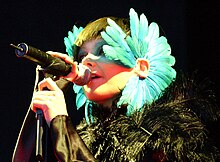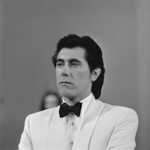Art pop
| Art pop | |
|---|---|
| Stylistic origins | |
| Cultural origins | Mid-1960s, United Kingdom and United States |
| Derivative forms | |
| Other topics | |
Art pop(also typesetart-poporartpop) is a loosely defined style ofpop music[1]influenced byart theories[7]as well as ideas from other art mediums, such asfashion,fine art,cinema,andavant-gardeliterature.[3][8]The genre draws onpop art's integration ofhighandlow culture,and emphasizessigns,style, and gesture over personal expression.[7][9]Art pop musicians may deviate from traditional pop audiences androck musicconventions,[10]instead exploringpostmodernapproaches and ideas such as pop's status ascommercial art,notions of artifice and theself,and questions ofhistorical authenticity.
Starting in the mid-1960s, British and American pop musicians such asBrian Wilson,Phil Spector,andthe Beatlesbegan incorporating the ideas of the pop art movement into their recordings.[1]English art pop musicians drew from theirart schoolstudies,[8]while in America the style drew on the influence of pop artistAndy Warholand the affiliated bandthe Velvet Underground.[11]The style would experience its "golden age" in the 1970s amongglam rockartists such asDavid BowieandRoxy Music,who embraced theatricality andthrowaway pop culture.[4]
Art pop's tradition continued in the late 1970s and 1980s through styles such aspost-punkandsynthpopas well as the BritishNew Romanticscene,[5][10]developing further with artists who rejected conventional rock instrumentation and structure in favor ofdancestyles and thesynthesizer.[10]The 2010s saw new art pop trends develop, such aship hopartists drawing onvisual artandvaporwaveartists exploring the sensibilities ofcontemporary capitalismand theInternet.
Characteristics
[edit]Art pop draws onpostmodernism's breakdown of the high/low cultural boundary and explores concepts of artifice and commerce.[12][nb 1]The style emphasizes the manipulation ofsignsover personal expression, drawing on an aesthetic of the everyday and the disposable, in distinction to theRomanticand autonomous tradition embodied byart rockorprogressive rock.[13][nb 2]SociomusicologistSimon Frithhas distinguished the appropriation of art into pop music as having a particular concern withstyle,gesture,and the ironic use of historical eras andgenres.[16]Central to particular purveyors of the style were notions of theselfas a work of construction and artifice,[10]as well as a preoccupation with the invention of terms, imagery, process, and affect.[17]The Independent's Nick Coleman wrote: "Art-pop is partly about attitude and style; but it's essentially about art. It is, if you like, a way of making pureformalismsocially acceptable in a pop context. "[18]
Cultural theoristMark Fisherwrote that the development of art pop evolved out of the triangulation of pop, art, andfashion.[10]Frith states that it was "more or less" directly inspired byPop art.[2][3][nb 3]According to criticStephen Holden,art pop often refers to any pop style which deliberately aspires to theformalvalues of classical music and poetry, though these works are often marketed bycommercialinterests rather than respected cultural institutions.[1]Writers forThe Independentand theFinancial Timeshave noted the attempts of art pop music to distance its audiences from the public at large.[20][21]Robert Christgauwrote inThe Village Voicein 1987 that art-pop results "when a fascination with craft spirals up and in until it turns into an aestheticist obsession."[22]
Cultural background
[edit]What seems clearer in retrospect [...] is a distinction between the first wave of art school musicians, the London provincialr & bplayers who simply picked up thebohemian attitudeand carried it with them into progressive rock, and a second generation, who applied arttheoriesto pop music making
—Simon Frith,Art into Pop(1988)[23]
The boundaries between art and pop music became increasingly blurred throughout the second half of the 20th century.[24]In the 1960s, pop musicians such asJohn Lennon,Syd Barrett,Pete Townshend,Brian Eno,andBryan Ferrybegan to take inspiration from their previousart schoolstudies.[3]Frith states that inBritain,art school represented "a traditional escape route for the bright working class kids, and a breeding ground for young bands likethe Beatlesand beyond ".[12]In North America, art pop was influenced byBob Dylanand theBeat Generation,and became more literary throughfolk music's singer-songwriter movement.[1]Before progressive/art rock became the most commercially successful British sound of the early 1970s, the 1960spsychedelic movementbrought together art and commercialism, broaching the question of what it meant to be an "artist" in a mass medium.[25]Progressive musiciansthought that artistic status depended on personal autonomy, and so the strategy of "progressive" rock groups was to present themselves as performers and composers "above" normal pop practice.[26]

Another chief influence on the development of art pop was the Pop art movement.[1]The term "pop art", first coined to describe the aesthetic value of mass-produced goods, was directly applicable to the contemporary phenomenon ofrock and roll(includingElvis Presley,an early Pop art icon).[27]According to Frith: "[Pop art] turned out to signal the end of Romanticism, to be an art without artists. Progressive rock was the bohemians' last bet [...] In this context the key Pop art theorist was not[Richard] Hamiltonor any of the other British artists who, for all their interest in the mass market, remained its academic admirers only, butAndy Warhol.For Warhol the significant issue wasn't the relative merits of 'high' and 'low' art but the relationship betweenallart and 'commerce'. "[28]Warhol'sFactoryhouse bandthe Velvet Undergroundwas an American group who emulated Warhol's art/pop synthesis, echoing his emphasis on simplicity, and pioneering a modernist avant-garde approach to art rock that ignored the conventional hierarchies of artistic representation.[29][nb 4]
1960s: Origins
[edit]Holden traces art pop's origins to the mid 1960s, when producers such asPhil Spectorand musicians such asBrian Wilsonof theBeach Boysbegan incorporating pseudo-symphonic textures to their pop recordings, as well as the Beatles' first recordings with a string quartet.[1][nb 5]In the words of author Matthew Bannister, Wilson and Spector were both known as "eremitic studio obsessives [...] [who] habitually absented themselves from their own work", and like Warhol, Spector existed "not as presence, but as a controlling or organising principle behind and beneath the surfaces of media. Both vastly successful commercial artists, and both simultaneously absent and present in their own creations."[35]
WriterErik Daviscalled Wilson's art pop "unique in music history",[36]while collaboratorVan Dyke Parkscompared it to the contemporaneous work of Warhol and artistRoy Lichtenstein,citing his ability to elevate common or hackneyed material to the level of "high art".[37][nb 6]In his 2004 bookSonic Alchemy: Visionary Music Producers and Their Maverick Recordings,David Howard credits the Beach Boys' 1966 single "Good Vibrations"with launching the" brief, shining moment [when] pop and art came together as unlikely commercial bedfellows. "[41]
In a move that was indicated by the Beatles, the Beach Boys, Phil Spector, andFrank Zappa,[42]the dominant format of pop musictransitioned from singles to albums,and many rock bands created works that aspired to make grand artistic statements, where art rock would flourish.[1]Musicologist Ian Inglis writes that the cover art for the Beatles' 1967 albumSgt. Pepper's Lonely Hearts Club Bandwas "perceived as largely responsible for the connections between art and pop to be made explicit".[43]AlthoughSgt. Pepper'swas preceded by several albums that had begun to bridge the line between "disposable" pop and "serious" rock, it successfully gave an established "commercial" voice to an alternative youth culture.[44]Author Michael Johnson wrote that art pop music would continue to exist subsequent to the Beatles, but without ever achieving their level of popular success.[33][nb 7]
The Whowas labelled "the first pop art band" by their manager, while member Pete Townshend explains: "We stand for pop art clothes, pop art music and pop art behaviour [...] we don't change offstage; we live pop art."[46]Frith considers their albumThe Who Sell Out(December 1967) "perhaps the Pop art pop masterpiece", the Who using the "vitality" of commerce itself, a tactic echoed byRoy Wood'sthe Moveand, later,Kevin GodleyandLol Cremeof10cc.[46]Townshend's ideas were notable for their emphasis on commercialism: "[His] use of Pop art rhetoric [...] referred not to music-making as such – to the issue of self-expression – but to commercial music-making, to issues of packaging, selling and publicizing, to the problems of popularity and stardom."[46]In a May 1967 interview, Townshend coined the term "power pop"to describe the music of the Who,the Small Faces,and the Beach Boys. Power pop later developed as a genre known for its reconfiguration of 1960s tropes. Music journalistPaul Lesterargued that this component could ratify power pop as one of the first postmodern music genres.[47]
1970s: New York scene and glam
[edit]
Music journalistPaul Lesterlocates "the golden age of adroit, intelligent art-pop" to when the bands10cc,Roxy MusicandSparks"were mi xing and matching from different genres and eras, well before the term 'postmodern' existed in the pop realm."[4]The effect of the Velvet Underground gave rock musicians likeIggy Popofthe Stoogesa self-consciousness about their work. Iggy was inspired to transform his personality into an art object, which would in turn influence singerDavid Bowie,and led to the Stooges' role as the group linking 1960shard rockto 1970spunk.[11]In the 1970s, a similarly self-conscious art/pop community (which Frith calls "the most significant" of the period) began to coalesce in theMercer Arts Centerin New York. The school encouraged the continuation of the kinds of collaboration between high and low art once exemplified by the Factory, as drummerJerry Harrison(later ofTalking Heads) explained: "it started with the Velvet Underground and all of the things that were identified with Andy Warhol."[11][nb 8]
Theglam rockscene of the early 1970s would again draw widely on art school sensibilities.[12]Inspired partly by the Beatles' use of alter egos onSgt. Pepper's,[48]glam emphasized outlandish costumes, theatrical performances, and allusions tothrowaway pop culturephenomena, becoming one of the most deliberately visual phenomena to emerge in rock music.[49]Some of its artists, like Bowie, Roxy Music, and ex-Velvet Underground memberLou Reed,would continue the practices associated with the modernist avant-garde branch of art rock.[14][nb 9]
Bowie, a former art-school student and painter,[12]made visual presentation a central aspect of his work,[52]deriving his concept of art pop from the work and attitudes of Warhol and the Velvet Underground.[53]Roxy Music is described by Frith as the "archetypical art pop band."[12]Frontman Bryan Ferry incorporated the influence of his mentor, pop art pioneerRichard Hamilton[49][54]while synthesizer playerBrian Enodrew on his study ofcyberneticsand art under theoristRoy Ascott.[55][nb 10]Frith posits that Ferry and Bowie remain "the most significant influences in British pop", writing they were both concerned with "popascommercial art ", and together made glam rock into an art form to be taken seriously, unlike other" camp "acts such asGary Glitter.This redefined progressive rock and revitalized the idea of the Romantic artist in terms of media fame.[57]According to Armond White, Roxy Music's engagement with pop art practices effectively "showed that pop's surface frivolity and deep pleasure were legitimate and commanding pursuits."[17]After leaving Roxy Music in 1973, Eno would further explore art pop styles on a series of experimental solo albums.[58][nb 11]For the rest of the decade, he developed Warhol's arguments in a different direction from his contemporaries, and collaborated with a wide range of popular musicians of the era.[57]
1970s–80s: Post-punk developments
[edit]Cultural theoristMark Fishercharacterized a variety of musical developments in the late 1970s, including post-punk,synthpop,and particularly the work of German electronic bandKraftwerk,[60]as situated within art pop traditions.[5]He states that Bowie and Roxy Music's English style of art pop "culminated" with the music of the British groupJapan.[8]The Quietuscharacterized Japan's 1979 albumQuiet Lifeas defining "a very European form of detached, sexually-ambiguous and thoughtful art-pop" similar to that explored by Bowie on 1977'sLow.[61]Brian Eno and John Cale would serve a crucial part in the careers of Bowie, Talking Heads, and many key punk andpost-punkrecords.[57]Following the amateurism of thepunk movement,post-punk era saw a return to the art school tradition previously embodied by the work of Bowie and Roxy Music,[62][5]with artists drawing ideas fromliterature,art,cinema,andcritical theoryinto musical and pop cultural contexts while refusing the common distinction betweenhigh artand low culture.[63][64][nb 12]An emphasis onmultimediaperformance and visual art became common.[64]
Fisher characterized subsequent artists such asGrace Jones,theNew Romanticgroups of the 1980s, andRóisín Murphyas a part of an art pop lineage.[10]He noted that the development of art pop involved the rejection of conventionalrockinstrumentation and structure in favor ofdancestyles and thesynthesizer.[10]The Quietusnames English New Romantic actDuran Duran,who were formatively influenced by the work of Japan, Kraftwerk and David Bowie, as "pioneering art pop up to arena-packing level", developing the style into "a baroque, romantic escape."[61]CriticSimon Reynoldsdubbed English singerKate Bush"the queen of art-pop", citing her merging of glamour, conceptualism, and innovation without forsaking commercial pop success during the late 1970s and 1980s.[68]
1990s–present: Online and beyond
[edit]
IcelandicsingerBjörkwas a prominent purveyor of art pop[69]for her wide-ranging integration of disparate forms of art and popular culture.[70]During the 1990s, she became art pop's most commercially successful artist.[71]Discussing Björk in 2015, Jason Farago ofThe Guardianwrote: "The last 30 years inart historyare in large part a story of collaborative enterprises, of collapsed boundaries between high art and low, and of the end of divisions between media. Few cultural figures have made the distinctions seem as meaningless as the Icelandic singer who combinedtrip hopwith12-tone,and who brought the avant garde toMTVjust before both those things disappeared. "[72]

According to Barry Walters ofNPR,1990s rap groupP.M. Dawndeveloped a style of "kaleidoscopic art-pop" that was initially dismissed byhip hopfans as "too soft, ruminative and far-ranging" but would eventually pave the way for the work of artists likeDrakeandKanye West.[74]In 2013,Spinnoted a "new art-pop era" in contemporary music, led by West, in which musicians draw on visual art as a signifier of wealth and extravagance as well as creative exploration.[75]Factlabels West's 2008 album808s & Heartbreakas an "art-pop masterpiece" which would have a substantive influence on subsequent hip hop music, broadening the style beyond its contemporary emphasis on self-aggrandizement and bravado.[76]The New York Times'Jon Caramanicadescribed West's "thought-provoking and grand-scaled" works as having "widened [hip hop]'s gates, whether formiddle-classvalues orhigh-fashionand high-art dreams. "[77]
Contemporary female artists who "merge glamour, conceptualism, innovation and autonomy," such asGrimes,Julia Holter,Lana Del ReyandFKA twigs,are frequently described as working in the tradition of Kate Bush.[68]Grimes is described by theMontreal Gazetteas "an art-pop phenomenon" and part of "a long tradition of fascination with the pop star as artwork in progress", with particular attention drawn to role of theInternetand digital platforms in her success.[78]
In a 2012 piece forDummy,critic Adam Harper described anaccelerationistzeitgeist in contemporary art-pop characterized by an ambiguous engagement with elements of contemporary capitalism.[6]He mentions the Internet-based genrevaporwaveas consisting of underground art-pop musicians likeJames FerraroandDaniel Lopatin"exploring the technological and commercial frontiers of 21st century hyper-capitalism's grimmest artistic sensibilities".[6]Artists associated with the scene may release music via online pseudonyms while drawing on ideas of virtuality and synthetic 1990s sources such as corporatemood music,lounge music,andmuzak.[6]
List of artists
[edit]Notes
[edit]- ^"If postmodernism means a breakdown of high/low cultural boundaries, it means too the end of this historical myth – which is where the art-pop musicians come in, complicating sociological readings of what music means, putting into play their own accounts of authenticity and artifice."[9]
- ^Historically, "art rock" has been used to describe at least two related, but distinct, types of rock music.[14]The first is progressive rock, while the second usage refers to groups who rejectedpsychedeliaand thehippie counterculturein favor of amodernist,avant-garde approach defined bythe Velvet Underground.[14]In the rock music of the 1970s, the "art" descriptor was generally understood to mean "aggressively avant-garde" or "pretentiously progressive".[15]
- ^Musicologist Allan Moore surmises that the term "pop music" itself may have originated from Pop art.[19]
- ^When the Velvet Underground first appeared in the mid 1960s, they faced rejection and were commonly dismissed as a "fag" band.[30]
- ^Through their influential work, Wilson and the Beatles' producerGeorge Martinspread the idea of therecording studioas a creative environment that could assist in the songwriting process.[32]Author Michael Johnson credits the Beach Boys'Pet Sounds(1966) and the Beatles'Sgt. Pepper's Lonely Hearts Club Band(1967) as the first documented "ascension" of rock and roll.[33]Spector has also been credited by journalistRichard Williamswith transforming rock music as a performing art to an art which could only exist in the recording studio, which "paved the way forart rock".[34]
- ^The Beach Boys were virtually disconnected from the cultural avant-garde, according to biographerPeter Ames Carlin,who concluded that – with the possible exception of Wilson – they "had [not] shown much discernible interest in what you might call the world of ideas."[38]Wilson's unreleasedSmile,conceived and recorded in 1966–67, has been described as an attempt to create "the great art pop album"[39]and the "preeminent psychedelic pop art statement" of the era.[40]
- ^Frith likened the album's elaborate design to "reading the underground press [...] [a skill that] was always constructed around a sense of difference from the 'mass' pop audience. Art rock was 'superior' to all levels. [...] the philistines had to be kept out." He also notes that Zappa targeted the issue of pop commercialism with the cover ofthe Mothers of Invention's 1968 albumWe're Only in It for the Money,which parodied the cover ofSgt. Pepper's.[45]
- ^Other students of the center includedLaurie Anderson,Suicide'sAlan Vega,andBlondie'sChris Stein.[11]
- ^Scholar Philip Auslander noted a pattern with artists who irreverently plundered older styles of music, such asBrill Buildingand Spector'sWall of Sound.[50]ProducerTony Viscontiremembers that in 1970, he, Bowie, andT. Rex'sMarc Bolanwould "get high and listen to Beach Boys albums and Phil Spector albums – we all had that in common, that we loved the Beach Boys."[51]
- ^Eno's initial musical influences were ideas from the classical avant-garde, likeJohn Cage's indeterminacy,La Monte Young's minimalism, and the Velvet Underground — specifically the band's John Cale.[56]
- ^Eno's 1970s work is cited by musicologistLeigh Landyas an archetypal example of a pop musician who "applied developments from the experimental sector while creating their ownexperimental popsector ".[59]
- ^Among major influences on a variety of post-punk artists werepostmodernnovelists such asWilliam S. BurroughsandJ. G. Ballardand avant-garde political movements such asSituationismandDada.[65]Additionally, in some locations the creation of post-punk music was closely linked to the development of efficacioussubcultures,which played important roles in the production of art,multimediaperformances,fanzinesrelated to the music. Simon Reynolds would note: "Beyond the musicians, there was a whole cadre of catalysts and culture warriors, enablers and ideologues who started labels, managed bands, became innovative producers, published fanzines, ran hipster record stores, promoted gigs and organized festivals."[66]
References
[edit]- ^abcdefghHolden, Stephen(February 28, 1999)."MUSIC; They're Recording, but Are They Artists?".The New York Times.RetrievedJuly 17,2013.
- ^abFrith & Horne 2016,p. 74.
- ^abcdBuckley 2012,p. 21.
- ^abcLester, Paul(June 11, 2015)."Franz and Sparks: this town is big enough for both of us".The Guardian.
- ^abcdeFisher, Mark (2010). "You Remind Me of Gold: Dialogue with Simon Reynolds".Kaleidoscope(9).
- ^abcdHarper, Adam (December 7, 2012)."Comment: Vaporwave and the pop-art of the virtual plaza".Dummy. Archived fromthe originalon April 1, 2015.RetrievedFebruary 8,2014.
- ^abFrith 1989,p. 116, 208.
- ^abcFisher 2014,p. 5.
- ^abBannister 2007,p. 184.
- ^abcdefgFisher, Mark (November 7, 2007)."Glam's Exiled Princess: Roisin Murphy".Fact.London. Archived fromthe originalon November 10, 2007.RetrievedNovember 23,2015.
- ^abcdFrith & Horne 2016,pp. 113–114.
- ^abcdeFrith 1989,p. 208.
- ^Frith & Horne 2016,p. 98.
- ^abcBannister 2007,p. 37.
- ^Murray, Noel (May 28, 2015)."60 minutes of music that sum up art-punk pioneers Wire".The A.V. Club.
- ^Frith 1989,p. 97.
- ^abWhite, Armond."The Best of Roxy Music Shows Ferry's Talent for Exploring Pop While Creating It".RetrievedMarch 15,2016.
- ^Coleman, Nick (August 31, 2003). "Live Box".The Independent.Independent Print Limited.
- ^Moore 2016,"The (Very) Long 60s", pp. 12–13.
- ^DJ Taylor (August 13, 2015)."Electric Shock: From the Gramophone to the iPhone: 125 Years of Pop Music by Peter Doggett, book review".The Independent.RetrievedMarch 15,2016.
- ^abAspden, Peter. "The Sound and Fury of Pop Music."Financial Times.14 August 2015.
- ^Christgau, Robert(February 24, 1987)."Christgau's Consumer Guide".The Village Voice.RetrievedApril 24,2019.
- ^Frith & Horne 2016,p. 100.
- ^Edmondson 2013,p. 1233.
- ^Frith & Horne 2016,p. 99.
- ^Frith & Horne 2016,pp. 74, 99–100.
- ^Frith & Horne 2016,p. 103.
- ^Frith & Horne 2016,p. 108.
- ^Bannister 2007,pp. 44–45.
- ^Bannister 2007,p. 45.
- ^Masley, Ed (October 28, 2011)."Nearly 45 years later, Beach Boys' 'Smile' complete".Arizona Central.
- ^Edmondson 2013,p. 890.
- ^abJohnson 2009,p. 197.
- ^Williams 2003,p. 38.
- ^Bannister 2007,pp. 38, 44–45.
- ^Davis, Erik(November 9, 1990)."Look! Listen! Vibrate! SMILE! The Apollonian Shimmer of the Beach Boys".LA Weekly.Archived fromthe originalon December 4, 2014.RetrievedJanuary 14,2014.
- ^Himes, Geoffrey."Surf Music"(PDF).teachrock.org.Rock and Roll: An American History. Archived fromthe original(PDF)on November 25, 2015.
- ^Carlin 2006,p. 62.
- ^Richardson, Mark (November 2, 2011)."The Smile Sessions review".Pitchfork.RetrievedJuly 16,2013.
- ^Staton, Scott (September 22, 2005)."A Lost Pop Symphony".The New York Review of Books.RetrievedSeptember 12,2013.
- ^Howard 2004,p. 66.
- ^Julien 2008,pp. 30, 160.
- ^Julien 2008,p. 102.
- ^Holm-Hudson 2013,p. 10.
- ^Frith & Horne 2016,pp. 57–58, 99.
- ^abcFrith & Horne 2016,p. 101.
- ^Lester, Paul(February 11, 2015)."Powerpop: 10 of the best".The Guardian.
- ^MacDonald 2005,p. 232.
- ^abMolon & Diederichsen 2007,p. 73.
- ^Auslander 2006,pp. 55, 86, 179.
- ^Curtis 1987,p. 263.
- ^Cavna, Michael."Beyond the music: How David Bowie was one of our smartest visual artists".The Washington Post.RetrievedMarch 14,2016.
- ^Jones, Jonathan (March 15, 2013)."David Bowie and the sexual stamina of Dorothy Iannones – the week in art".The Guardian.RetrievedMarch 5,2016.
- ^Walker, John. (1987)"Bryan Ferry: music + art school"ArchivedSeptember 5, 2017, at theWayback Machine.Cross-Overs: Art into Pop, Pop into Art.
- ^Shanken, Edward (2002)."Cybernetics and Art: Cultural Convergence in the 1960s"(PDF).responsivelandscapes.
- ^Frith & Horne 2016,p. 117.
- ^abcFrith & Horne 2016,p. 116.
- ^Heller, Jason (June 14, 2012)."Getting started with Brian Eno, glam icon and art-pop pioneer".The A.V. Club.Chicago.RetrievedJuly 17,2013.
- ^Landy 2013,p. 167.
- ^Fisher 2014,p. 36.
- ^abSparham, Maddy (March 31, 2013)."Duran Duran Versus Japan: The Substance Of Style".The Quietus.RetrievedJanuary 8,2017.
- ^Rojek 2011,p. 28.
- ^Anindya Bhattacharyya."Simon Reynolds interview: Pop, politics, hip-hop and postpunk"Socialist Worker.Issue 2053, May 2007.
- ^abReynolds 2006,p. xxxi.
- ^Reynolds 2006,p. 7.
- ^Reynolds 2006,p. 29.
- ^Cashen, Calvin (March 8, 2016)."Top art pop albums of the '80s".The Corncordian.
- ^abReynolds, Simon (August 21, 2014)."Kate Bush, the queen of art-pop who defied her critics".The Guardian.RetrievedMarch 5,2016.
- ^Hermes, Will (January 23, 2015)."Vulnicura Album Review".Rolling Stone.Wenner Publishing. Archived fromthe originalon March 25, 2016.RetrievedMarch 6,2016.
- ^"Björk's Been ARTPOP Since Before Gaga Was Born This Way".The Huffington Post.July 17, 2013.RetrievedJanuary 2,2016.
- ^Hunter, James (October 1997)."Björk – Homogenic".Spin.Vol. 13, no. 7. Spin Media.ISSN0886-3032.RetrievedMarch 6,2016.
- ^Farago, Jason (March 4, 2015)."Björk review – a strangely unambitious hotchpotch".The Guardian.RetrievedMarch 4,2015.
- ^Greenburg, Zack O'Malley."Kanye West Makes His Own Artpop On Yeezus Tour".Forbes.RetrievedJuly 25,2016.
- ^Walters, Barry."Dev Hynes Wants To Know What It Feels Like To Be Free".NPR.RetrievedAugust 22,2016.
- ^Shepherd, Julianne Escobedo."Pop for Art's Sake Goes Varoom!".Spin.RetrievedJuly 25,2016.
- ^Twells, John (June 18, 2010)."Drake: Thank Me Later".Fact Magazine.RetrievedJuly 25,2016.
- ^Caraminica, Joe (June 11, 2013)."Behind Kanye's Mask".The New York Times.
- ^O'Mara, Jamie."Grimes's star shines online".Montreal Gazette.RetrievedMarch 12,2016.
Bibliography
[edit]- Auslander, Philip (2006).Performing Glam Rock: Gender and Theatricality in Popular Music.University of Michigan Press.ISBN0-472-06868-7.
- Bannister, Matthew (2007).White Boys, White Noise: Masculinities and 1980s Indie Guitar Rock.Ashgate Publishing, Ltd.ISBN978-0-7546-8803-7.
- Buckley, David (2012).Strange Fascination: David Bowie: The Definitive Story.Random House.ISBN978-1-4481-3247-8.
- Carlin, Peter Ames(2006).Catch a Wave: The Rise, Fall, and Redemption of the Beach Boys' Brian Wilson.Rodale.ISBN978-1-59486-320-2.
- Curtis, James M. (1987).Rock Eras: Interpretations of Music and Society, 1954–1984.Popular Press.ISBN978-0-87972-369-9.
- Howard, David N. (2004).Sonic Alchemy: Visionary Music Producers and Their Maverick Recordings(1st ed.). Milwaukee, WI: Hal Leonard Corp.ISBN0634055607.
- Molon, Dominic; Diederichsen, Diedrich (2007).Sympathy for the Devil: Art and Rock and Roll Since 1967.Yale University Press.ISBN978-0-300-13426-1.
- Edmondson, Jacqueline, ed. (2013).Music in American Life: An Encyclopedia of the Songs, Styles, Stars, and Stories that Shaped our Culture.ABC-CLIO.ISBN978-0-313-39348-8.
- Fisher, Mark(2014)."'Just When I Think I'm Winning'".Ghosts of My Life: Writings on Depression, Hauntology and Lost Futures.Zero Books.ISBN978-1-78099-226-6.
- Frith, Simon(1989).Facing the Music: A Pantheon Guide to Popular Culture.Pantheon Books.ISBN0-394-55849-9.
- Frith, Simon;Horne, Howard (2016) [First published 1988].Art Into Pop.Routledge.ISBN978-1-317-22803-5.
- Holm-Hudson, Kevin, ed. (2013).Progressive Rock Reconsidered.Routledge.ISBN978-1-135-71022-4.
- Landy, Leigh(2013).What's the Matter with Today's Experimental Music.Routledge.ISBN978-3-7186-5168-9.
- MacDonald, Ian(2005).Revolution in the Head: The Beatles' Records and the Sixties(3rd ed.). Chicago Review Press.ISBN978-1-55652-733-3.
- Johnson, Michael (2009).Pop Music Theory.Lulu.ISBN978-0-578-03539-0.[self-published source]
- Julien, Oliver (2008). Julien, Olivier (ed.).Sgt. Pepper and the Beatles: It Was Forty Years Ago Today.Ashgate.ISBN978-0-7546-6708-7.
- Moore, Allan F. (2016).Song Means: Analysing and Interpreting Recorded Popular Song.Routledge.ISBN978-1-317-05265-4.
- Reynolds, Simon(2006).Rip It Up and Start Again: Postpunk 1978–1984.Penguin Publishing Group.ISBN978-1-101-20105-3.
- Rojek, Chris (2011).Pop Music, Pop Culture.Polity.ISBN978-0-7456-4263-5.
- Williams, Richard(2003).Phil Spector: Out of His Head.Music Sales Group.ISBN978-0-7119-9864-3.
Further reading
[edit]- Gendron, Bernard (2002).Between Montmartre and the Mudd Club: Popular Music and the Avant-Garde.University of Chicago Press.ISBN978-0-226-28737-9.
- Harron, Mary (1980)."Pop Art/Art Pop: The Andy Warhol Connection".InHoskyns, Barney(ed.).The Sound and the Fury: 40 Years of Classic Rock Journalism: A Rock's Backpages Reader.Bloomsbury USA (published 2003).ISBN978-1-58234-282-5.(subscription required)
- Waterman, Bryan (2011).Television's Marquee Moon.Bloomsbury Publishing.ISBN978-1-4411-4529-1.



